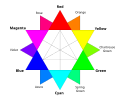| Bronze | |
|---|---|
| | |
| Hex triplet | #CD7F32 |
| sRGB B (r, g, b) | (205, 127, 50) |
| HSV (h, s, v) | (30°, 76%, 80%) |
| CIELChuv (L, C, h) | (60, 81, 39°) |
| Source | 99colors.net [1] /Maerz and Paul [2] |
| ISCC–NBS descriptor | Strong orange |
| B: Normalized to [0–255] (byte) | |

Bronze is a metallic brown color which resembles the metal alloy bronze.
Contents

The first recorded use of bronze as a color name in English was in 1753. [3]

